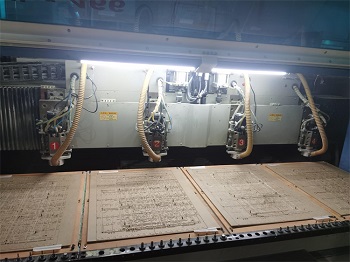From:sochi
We have identified some issues regarding the PCB drilling machine hole: too big, too small, or distortion. We would like to take this opportunity to let you know the causes and solutions of the issue.
The causes are: wrong specification of drill nozzle; inappropriate feed speed or speed; excessive wear of drill nozzle; too many times of resharpening of drill nozzle or the bottom of the chip rejection slot length is lower than the standard; excessive deflection of the spindle itself; chipping of drill nozzle and large hole diameter; wrong hole diameter; no hole diameter measurement when changing drill nozzle; wrong arrangement of drill nozzle; wrong position when changing drill nozzle; no checking of hole diameter diagram; the spindle can not be placed on the tool, causing knife press on the tool; wrong serial number input in the parameters.The wrong serial number is entered in the parameters.

The solutions are as follows:
1. Check the drill size and control system before operation.
2. Adjust the feed rate and speed to the most ideal state.
3. Replace the drill nozzles and limit the number of holes per drill nozzle. Usually drill 3000-3500 holes for double-sided boards (four per stack); 500 holes on high-density multilayers; 3000 holes for FR-4 (three per stack); and 30% less on average for the harder FR-5.
4. Limit the number of drill regrinds and regrind size variation. For drilling multi-layer panels sharpen once for every 500 holes drilled and allow sharpening 2~3 times; for every 1000 holes drilled you can sharpen once; for double-sided panels every 3000 holes drilled, sharpen once, then drill 2500 holes; then sharpen once to drill 2000 holes. Drill resharpening at the right time can increase the number of drill resharpening and increase the life of the drill. The depth of wear should be less than 0.2mm in the whole length of the two main cutting edges as measured by the tool microscope, and 0.25mm should be removed when resharpening. 3 times for fixed-shank drills and 2 times for spade drills.
5. Before drilling, check the tool surface with a 20x mirror and sharpen or scrap the bad drill bit.
6. Check and measure several times.
7. When replacing the drill bit, measure the next drill bit, and measure the first hole drilled when the drill bit has been replaced.
8. When arranging drill bits, count the location of the tool magazine.
9. When replacing drill bits, check the serial number clearly.
10. When preparing the tool, check the actual hole diameter of the hole diameter chart one by one.
11. Clean the clamping nozzles and carefully measure and check the condition of the tool surface after causing knife press.
We hope that these solutions can be of help for the PCB drilling machine hole issues. If you have further questions or concerns, please do not hesitate to contact us.